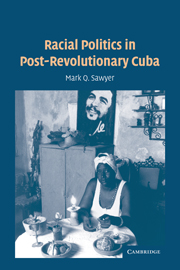Book contents
- Frontmatter
- Contents
- List of Figures and Tables
- Acknowledgments
- Introduction
- 1 Race Cycles, Racial Hierarchy, and Inclusionary Discrimination: A Dynamic Approach
- 2 Freedom and Discrimination: Uneven Inequality and Inclusion in Pre-Revolutionary Cuba
- 3 Race and Revolution: Transformation and Continuity
- 4 Match Made in Heaven or Strange Bedfellows? Black Radicals in Castro's Cuba
- 5 Race and Daily Life in Cuba During the Special Period: Part I: Interview Data
- 6 Race and Daily Life in Cuba During the Special Period: Part Ⅱ: Survey Research
- 7 Racial Politics in Miami: Ninety Miles and a World Away
- Conclusion
- Bibliography
- Index
3 - Race and Revolution: Transformation and Continuity
Published online by Cambridge University Press: 05 September 2012
- Frontmatter
- Contents
- List of Figures and Tables
- Acknowledgments
- Introduction
- 1 Race Cycles, Racial Hierarchy, and Inclusionary Discrimination: A Dynamic Approach
- 2 Freedom and Discrimination: Uneven Inequality and Inclusion in Pre-Revolutionary Cuba
- 3 Race and Revolution: Transformation and Continuity
- 4 Match Made in Heaven or Strange Bedfellows? Black Radicals in Castro's Cuba
- 5 Race and Daily Life in Cuba During the Special Period: Part I: Interview Data
- 6 Race and Daily Life in Cuba During the Special Period: Part Ⅱ: Survey Research
- 7 Racial Politics in Miami: Ninety Miles and a World Away
- Conclusion
- Bibliography
- Index
Summary
The Cuban Revolution was a watershed moment in Cuban racial history. Despite the huge changes it made to the racial landscape, however, many critical aspects of racial ideology remained the same after the revolution. The regime of Fidel Castro forged a racial ideology that was based upon pre-existing Cuban attitudes toward race, the practical circumstances of the moment, and a new vision for Cuba, combining old attitudes with a new state ideology: Marxism. But unequal pre-revolutionary access to education and economic resources, pre-existing racial ideology, inequality in housing and labor markets, and, after the collapse of the Soviet Union, unequal access to dollars all established the conditions for ongoing racial inequality. The war in Angola, which was caused by the geopolitical position of Cuba and the symbolic importance of military involvement in Africa, represented an opening of opportunities for blacks, and the subsequent Cuban economic collapse represented a significant retreat that will be explored in the latter chapters of the book in greater depth. Since the revolution, then, there has been a series of openings and consolidations that follow the race cycles theory, and alterations in race relations have reinforced a situation of inclusionary discrimination on the island.
This chapter examines the Cuban Revolution and its transformation of Cuban racial politics. It argues that the consolidation of the revolution, while institutionalizing important racial reforms, attempted to make racial problems invisible.
- Type
- Chapter
- Information
- Racial Politics in Post-Revolutionary Cuba , pp. 49 - 78Publisher: Cambridge University PressPrint publication year: 2005

